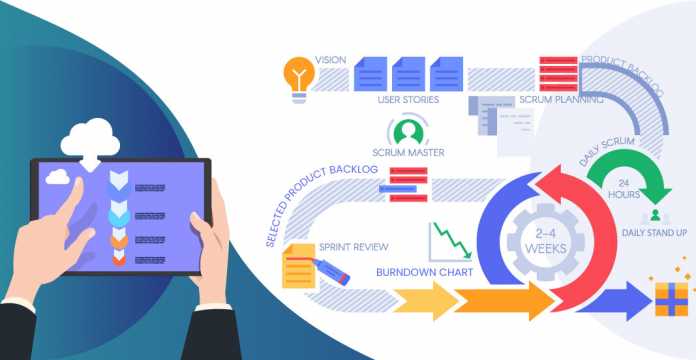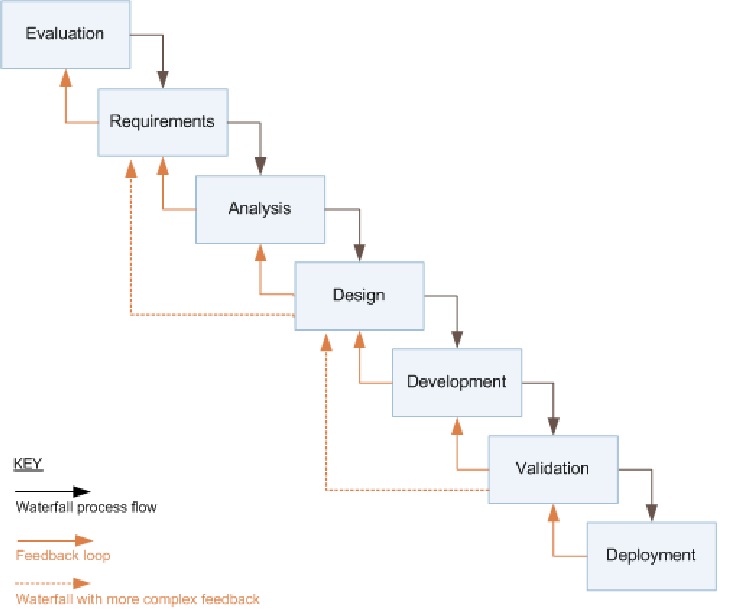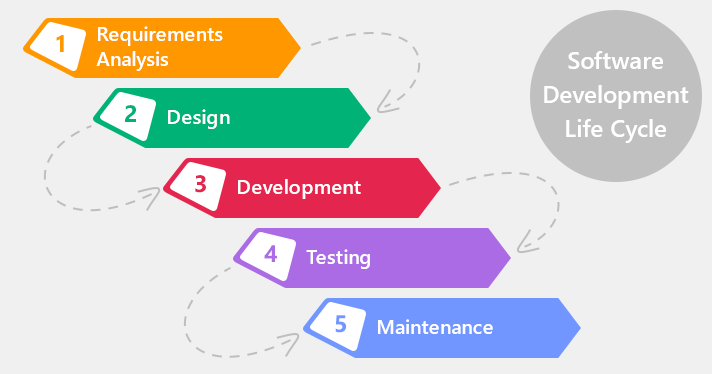
The business world has become competitive today and has transformed dramatically since the advent of the internet. Technology has created a more dynamic and fast-moving business environment and because of this most of the organizations of today are entirely project-driven.
A project is a series of operations implemented in an orderly manner to attain pre-determined success criteria or business goals. Thus, managing a project is considered to be a crucial aspect of any job. There are various methodologies and frameworks that act as a blueprint for the successful accomplishment of the project.
Agile and Waterfall model are two prominent approaches used for delivering projects. However, these two approaches can be confusing when used for the same project/when used at the same time. Let’s discuss each of them in-depth.
Waterfall Model – Definition

The concept of the waterfall model incorporates a step-wise/sequential approach to project development. The project’s progress flows progressively downward through all the phases, similar to a waterfall.
According to a recent study by PMI, “51% of the organizations use waterfall methodology.”
The “waterfall model” is also known as the” traditional” approach to project development and is known for taking things slow and steady. Each phase has to be finalized before moving on to the subsequent one.
On considering the waterfall methodology, you are aiming for a successful outcome as a result of meticulous planning at each phase in the process. Waterfall methodology mainly emphasis on accuracy.

Here is a list of various steps involved in implementing/executing a project using a waterfall methodology.
Requirement Analysis
Requirement analysis is the initial phase in the waterfall model. Requirements are thoroughly gathered at the initial phase of the project. You need to make thorough research and define the target market, set of specific guidelines, and customers. This phase serves as basis for further development and consumes up to 40% of the project time and budget.
Design
This phase involves how specifically the system requirements will be technically implemented. The design phase is broken down into physical and logical design sub-phases.
Implementation
The implementation phase involves the developer’s team to gather all the requirements from the previous steps and start developing the actual code.
Testing and Deployment
The testers try to come up with any issues with the product. If they happen to come across any severe defects, it is advised to go back to previous steps to find the root cause of the issue. Make a note of where actually improvements can be made and ahead towards the final step.
Maintenance
The maintenance phase not only includes just the deployment phase but also supports to keep the product functional and informed.
This phase explains that every stage until here is on proper track now. The product developed is ready to launch. Check for any errors before taking it live.
The mentioned-above phases follow a linear order, wherein each step can’t be instigated further until the previous stage has been accomplished.
Agile Model- Definition
With the change in time, Agile has been expanding its presence to various business segments due to changes in customer needs and market requirements and to make the process more effective and more comfortable than before.
Agile methodology is defined as a modern, iterative, and adaptable approach to managing a project. It permits you to breakdown a large project into easier and convenient tasks which are accomplished in short iterations. Every iteration is referred to as a single development cycle and is reviewed by the concerned team.
According to PWC, projects managed using this approach is 28% more successful than traditional projects.
Agile methodology allows the entire team to adapt to changes quickly with fewer alterations, which in turn end in the successful completion of the project despite the odds encountered. This methodology relies on customer involvement all through the development process.
Now let’s understand what all the steps involved in Agile methodology are:

Every iteration in Agile life cycle has an accurate time completion phase that lasts for two to four weeks.
You can visualize the iteration process as follows:
Agile workflow comprise of following steps:
In requirement phase, you are supposed to define all the essential elements for iteration. This phase is reliant on customer feedback, stakeholder feedback, and product backlog.
Development
Development phase involves developing and designing software based on the defined requirements.
Testing
Testing phase involves documentation development, quality analysis, internal and external training.
Delivery
Delivery and integration of the development phase into production.
Feedback and Maintenance
Take customer and stakeholder input and work according to next iteration requirement.
At the final step, you can make the product visible after various rounds of quality checks and analysis.
Factors that Distinguish these Methods / Agile vs. Waterfall

Source: lucidchart
| Waterfall | Agile |
| Waterfall methodology is a sequential and planned approach | Agile is an adaptive and iterative approach |
| Less responsive to change | Involves a lot of change |
| A test plan is rarely discussed | A test plan is reviewed after each phase |
| There are chances of changing the product requirements once the development phase starts | Specifications can be changed at any step, even if the initial planning is done |
| Involves a large team and gradually reduces team coordination | Agile methodology targets small size or mid-sized organizations with a high degree of coordination and synchronization |
| A detailed description is required to implement the process | Project details can be altered at any phase |
| Testing phase comes right after the build phase | Testing is done together with the development phase |
| The process is accomplished as a single project | This methodology is considered a collection of various projects |
| The process doesn’t entirely depend on its feasibility | The process looks better when it is feasible. |
| The process requires customers at certain milestones | The process requires the customers to be available throughout the project phase |
| As the process is straightforward, PM plays a vital role requirements gathering phase till implementation phase | There is no need for PMs during the entire process as the team members could be interchanged at any phase, and these results in faster work production |
| The process works well by increasing the funding efficiency | The process works well by reducing the funding |
Pros and Cons of Agile and Waterfall methodology
Waterfall Methodology
Pros:
- The static and predictable workflow nature of this model makes it simple to create timelines, cost estimation, and stick to schedules
- The waterfall model requires clear documentation of each phase in the process
- The waterfall methodology is suitable for the projects which require various software components
- Projects progress can be easily measured and evaluated
- The team doesn’t need any prior knowledge to start working on a project
- Having a well-documented project and estimated timelines make it simple and easy to give timely updates to senior management
- It’s quite easy to manage due to easy review process and distinct deliverables
- It facilitates the speedy delivery of the product
- The project undertaken is entirely reliant on the team with less client intervention
- A quality assurance test is performed before the completion of each phase
Cons:
- Each phase in the process is dependent on others. Change in one step leads to change in other phases as well. Water methodology leads to higher time consumption
- The process is not suitable for projects that have frequently changing requirements
- Small changes in the middle of the process may lead to quite a lot of issues
- The stakeholders/customers can’t see the working of a project until completion of all phases before coding
- Documentation consumes more time
- Customers and stakeholders don’t have any idea regarding what they want until they take a view of the working project. The waterfall model manages requirements gathering at the initial phase, so there are chances of missing the essential aspects down the line
- There is a high tendency to neglect the testing phase, which can be risky for a project
Agile Methodology
Pros:
- Customer satisfaction can be quickly done through rapid and continuous delivery
- Agile provides better adaptability to changes with quick response
- Special attention to design and technical details enhance agility
- Agile facilitates regular cooperation between the developers and the stakeholders
- People interaction is emphasized rather than any process and tools
- The Agile methodology supports a continuous development pace
- You will get instant feedback
- You can fix issues quickly
Cons:
- In the case of large and complex projects, it’s quite challenging to assess the effort required during the initial phase of the project
- Agile provides the least priority to designing and documentation, which can lead to problems
- Organizations can easily step off the project if the customer is not transparent with the outcome
- There is no pre-defined plan. The agile technique works at its best when the designers are capable of being agile
- Senior programmers are proficient in taking decisions required for the development process. So there is no place for amateur programmers lacking experienced resources
Also check out the blog and understand the differences between agile and iterative model.
What Makes the Agile Methodology so Unique?
There are varied factors that fit better for Agile methodology over the waterfall. Here are a few:
- Projects with unclear requirements/project deliverables
- Projects with scope for changing requirements
- Projects where the cost of change is minimal
- Projects that emphasize on continuous improvement and transparency
- Projects that are larger and undefined
What Makes the Waterfall Methodology so Unique?
There are different factors that better fit for waterfall model over the agile. Here are a few:
- Projects with budget constraints, period, and fixed scope.
- Projects with high interdependencies and risks can go with waterfall methodology.
- Projects that possess compliance and regulatory requirements.
- Projects that are smaller, simpler, and well-defined.
- Projects that have certainty on requirements.
- Projects having well-defined goals and static( that are not likely to change)
How Both Agile and Waterfall can Work Together for your Business?
After knowing the pros and cons, principles of both the methodologies now let’s understand how these two can work together for the successful execution of a project.
Be it Agile or Waterfall; none of the methodologies is perfect in all aspects. Though the Waterfall methodology sounds outdated, yet facilitates more paybacks/ profits when it comes to systemization and completion of the projects. On the other hand, though the agile methodology is influencing, it doesn’t provide a single solution to all the given projects.
The Agile-waterfall model is best applicable for the projects that require the team to deliver continually changing requirements within the given duration.
While you implement a particular methodology during the planning stage, the best way is to choose the method that the project requires. Moreover, the team should have thorough understanding of either of the model along with implementation steps. Else, you will result in creating a mess without any benefits.
The significant benefits of both the methodologies come as an outcome of blend between both the methodologies:
- Improved predictability
- Ability to respond timely to team members, management, and the users
Which Model is Suitable for Your Organization?
There is definitely no precise answer to this query. One can’t thoughtlessly say that Agile is superior to the latter. It ultimately depends on the level of clarity and project requirements.
You can incorporate Agile methodology on lacking a thorough understanding of the outcome, when a complex project is involved, or when you anticipate changes in the project. The process can accommodate new requirements at any phase in the project, but it is not the same with the waterfall model wherein you can’t go back to the preceding stage and make necessary changes.
Contrarily, the Waterfall model can be considered as a better model if you possess thorough understanding of the final product. The waterfall model is entirely suitable for your project if it is relatively simple and also when the requirements will not change regularly. If you are not interested in dealing with any changes, then this is a potent process for you to consider.
Conclusion
Thus aforementioned are a few pros and cons of both the approaches used in enterprises worldwide. Each is different from one another in terms of operation and implementation.
If the project scope is constant/fixed, then go with the waterfall methodology. However, if you work in a dynamic work environment, then Agile is the way to go. In this regard, individuals, and enterprise teams are getting trained in some fo the widely-recognized Agile Certification Courses and Project Management Certification Courses to ensure project team members are on the right track and achieve project success.
Agile and waterfall methodology is used by most of the organizations today. Organizations use it in various contexts. Using these methodologies is all about considering the best fit for your project. The term “best fit” involves multiple aspects like stakeholder expectations, available resources, budget, market perception, and project requirements. Considering all the above elements, make the best decision for your project and organization.
^ Image source: ResearchGate














